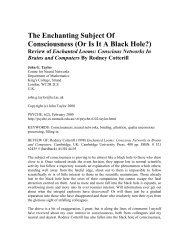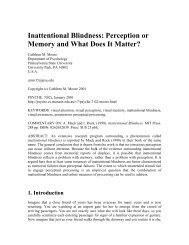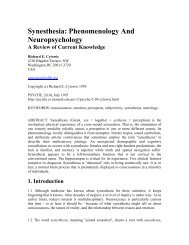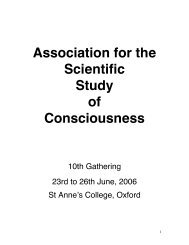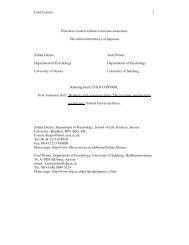Visual Agnosia and Higher- Order Thought Theory
Visual Agnosia and Higher- Order Thought Theory
Visual Agnosia and Higher- Order Thought Theory
Create successful ePaper yourself
Turn your PDF publications into a flip-book with our unique Google optimized e-Paper software.
A slight modificationMy own view is that, when one has a firstorderconscious state, the HOT is better viewedas intrinsic to the overall conscious state, so thatwe have a complex conscious state with parts.Conscious mental states are then bestunderstood as global brain states which arecombinations of passively received perceptualinput <strong>and</strong> presupposed higher-order conceptualactivity directed at that input. Concepts in themeta-psychological thoughts are thuspresupposed in having first-order consciousstates.
seen in various parts of the course st<strong>and</strong>ing as a silent reminder of the plantation days gone by.For some years too until the new Clubhouse building was formally opened in 1971, members wereaccommodated in what was known as the old Clubhouse - the former Seaport Estate manager's woodenbungalow situated between the third <strong>and</strong> fifteenth greens. It was quaintly described at one time as "aramshackle wood <strong>and</strong> plaster building with three showers in an outhouse" <strong>and</strong> the membership whichexceeded 500 then naturally complained of the lack of privacy!More than its historical links with Seaport Estate <strong>and</strong> the Sungei Way area, KGNS owes its origins almostentirely to one man - Tunku Abdul Rahman. It was the Tunku who conceived of the idea when he quietly gotthe Ministry of the Interior in 1963 to look into the feasibility of building a new golf course for Kuala Lumpur,at the rubber estate on the Batu Tiga Road near Sungei Way. At that time the main Golf Club in KualaLumpur, the Royal Selangor, already had a membership of 1,500 of whom not less than 1,300 were believedto be active golfers.
More on Associative <strong>Visual</strong> <strong>Agnosia</strong>• Difficulty on naming tasks <strong>and</strong> grouping objectstogether.• Normal recognition of objects through modalitiesother than vision, e.g. by touching the object.• Intact basic visual perception, e.g. patients cancopy objects or drawings that they cannotrecognize.• Patients will often see the details or parts of anobject, but not the “whole” of an object at aglance.
A Problem for HOT <strong>Theory</strong>• It thus seems possible to have aconscious experience of an object (albeit,an abnormal experience) in the absenceof higher-order conceptualization of theincoming visual information.• There is a first-order perception of anobject without the accompanying conceptof that object. Thus, its “meaning” is gone<strong>and</strong> the object is not recognized.
HOT theory <strong>and</strong> associative agnosia: A reply• It should first be noted that, if HOT theory is true,there must be some HOT for there to be aconscious state at all. So a HOT theorist canstill hold that some other HOT is present in suchabnormal cases, which reflects the way that thepatient is experiencing the object (e.g. a whistleor paintbrush). For example, if a patientexperiences object O (mistakenly) as someother object O’, then the HOT would have the O’concept in it. If they experience object O only bycertain parts or fragments, then those conceptswill be in the relevant HOT. Thus, no problemso far. There is no reason to suppose that theseHOTs are entirely absent in such cases.
REPLY (cont.)• It is also important to recognize that associativeagnosics still do have the relevant correctconcept because the evidence shows thatpatients can apply it to other modalities (e.g.touch, hearing). For example, identifying awhistle by sound but not by sight. The problemis simply that, in cases of vision, the mechanismby which the appropriate concept is triggered isclearly defective. So while one might be said tobe having a conscious visual perception of awhistle in some sense, the patient is notexperiencing the object as a whistle.
It is helpful to view this in light of another objection to HO theory:The problem of misrepresentation: An important objection toHO approaches is the question of just how such theories canexplain cases where the HO state might misrepresent thelower-order (LO) mental state (Levine 2001). If we are dealingwith a representational relation between two states, it seemspossible for misrepresentation or malfunction to occur. If itdoes, then what explanation can be offered by the HO theorist?If my LO state registers a red percept <strong>and</strong> my HO stateregisters a thought about something green due, say, to someneural misfiring, then what happens? It seems that problemsloom for any answer from a HO theorist <strong>and</strong> the cause of theproblem has to do with the very nature of the HO theorist’sbelief that there is a representational relation between the LO<strong>and</strong> HO states. For example, if the HO theorist takes the optionthat the resulting conscious experience is reddish, then itseems that the HO state plays no role in determining thequalitative character of the experience.
This is an objection that must be takenseriously <strong>and</strong> it forces HO theorists to beclearer about just how to view therelationship between the LO <strong>and</strong> HOstates. One possible reply to thisobjection is to construe the LO <strong>and</strong> HO aspart of the same integrated global state,so that misrepresentation arguably cannotoccur. That is, a coherent <strong>and</strong> accurateconscious state only occurs when the LO<strong>and</strong> HO concepts match.
Associative <strong>Agnosia</strong> <strong>and</strong> MisrepresentationThe visual agnosic consciously perceives things, but cannotrecognize what they are. They often mistake one object for another;for example, even mistaking one’s wife for a hat (Sacks, 1987). Thisdiffers from Levine’s case in that we are referring to the perceptionof objects as opposed to color perception. <strong>Visual</strong> agnosics are alsonot blind <strong>and</strong> do not have damage to the relevant areas of the visualcortex (contrast this with blindsight). However, a HOT theorist mightview this as an unusual case where the typical HOT does not“match up” with the first-order visual input. Thus, it seemsreasonable to view associative agnosia as a case where the “normal”concept in the HOT does not accompany the input received throughthe visual modality. So, as was mentioned earlier, associativeagnosia would be a case where the LO state registers a percept ofan object O, but the HO state (mistakenly) associates a concept ofO’ with LO. Bare visual perception remains but is confused <strong>and</strong>loses meaning due to the lack of a matching concept, resulting in adifferent <strong>and</strong> rather confusing phenomenological experience.
Integrative <strong>Agnosia</strong>• From Riddoch <strong>and</strong> Humphreys (1987)• A common <strong>and</strong> more specific kind of associativeagnosia• In light of the misrepresentation issue, perhapswe can also sometimes underst<strong>and</strong> associativeagnosia more specifically as a problem of the“impaired integration of local shape parts intohigher-order shapes.” (Farah 2004, p. 78)• Agnosics often mistakenly guess at the identityof an object (e.g. calling a baby carriage a“bicycle”) on the basis of a single feature (e.g.wheels)
Integrative <strong>Agnosia</strong> (cont.)• This has suggested to many that there is a “hierarchicalsystem of shape representation, whose lower-level partrepresentations are relatively intact but whose higherlevelintegration of the parts is damaged…” (Farah 2004,p. 78)• Relative to HOT theory, this also suggests that it is bestto hold that it takes the integration of both the LO state<strong>and</strong> the HOT to produce a coherent <strong>and</strong> accurate visualexperience of an object. Otherwise, a loss of “global” or“gestalt” perception occurs. But this is not a problem forHOT theory as such; if anything, HOT theory can neatlyexplain what has gone wrong.
ConclusionAssociative agnosia can actually be neatlyexplained by HOT theory, rather thanbeing a serious difficulty for the theory.Such cases reinforce the explanatorypower of HOT theory in terms of theimportance of matching HO concepts toLO input. These cases also show theadvantage of underst<strong>and</strong>ing normal visualperception as genuine integrations of LO<strong>and</strong> HO states.
References• Gennaro, R.J. 1996. Consciousness <strong>and</strong> Self-consciousness: A Defense ofthe <strong>Higher</strong>-<strong>Order</strong> <strong>Thought</strong> <strong>Theory</strong> of Consciousness. Amsterdam &Philadelphia: John Benjamins.• Gennaro, R.J. 2004. “<strong>Higher</strong>-order thoughts, animal consciousness, <strong>and</strong>misrepresentation: A reply to Carruthers <strong>and</strong> Levine.” In Gennaro 2004a.• Gennaro, R.J., ed. 2004a. <strong>Higher</strong>-<strong>Order</strong> Theories of Consciousness: AnAnthology. Amsterdam <strong>and</strong> Philadelphia: John Benjamins.• Farah, M. 2004. <strong>Visual</strong> <strong>Agnosia</strong>, second ed. Cambridge, MA: MIT Press.• Levine, J. 2001. Purple Haze: The Puzzle of Conscious Experience.Cambridge, MA: MIT Press.• Riddoch, M.J. & Humphreys, G.W. 1987. A case of integrative visualagnosia. Brain, 110, 1431-1462.• Rosenthal, D.M. 2005. Consciousness <strong>and</strong> Mind. Oxford University Press.• Sacks, O. 1987. The Man who Mistook His Wife for a Hat. New York:Harper & Row.• Teuber, H.L. 1968. Alteration of perception <strong>and</strong> memory in man. In L.Weiskrantz ed. Analysis of Behavioral Change. New York: Harper & Row.




